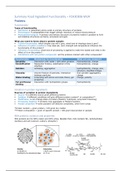Summary
Summary Food Ingredient Functionality - Protein part
- Course
- Institution
Don't feel like reading all 58 pages of the reader Food Ingredient Functionality? This summary describes all theory of the Protein part (reader, knowledgde clips, lectures) in just 6 pages! The content of the summary is: - Functionality - Variation in protein ingredients - Milk proteins - Protein...
[Show more]



